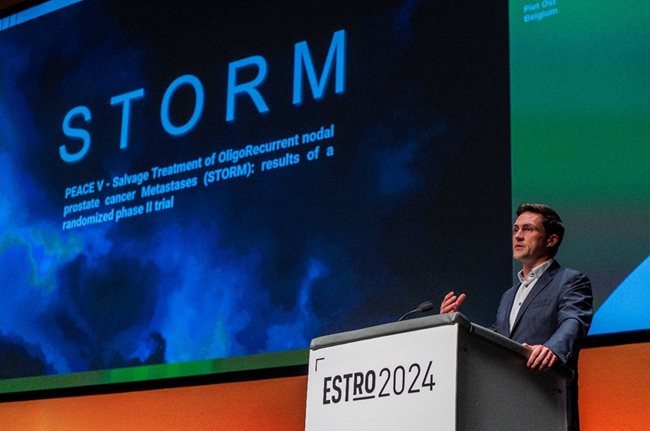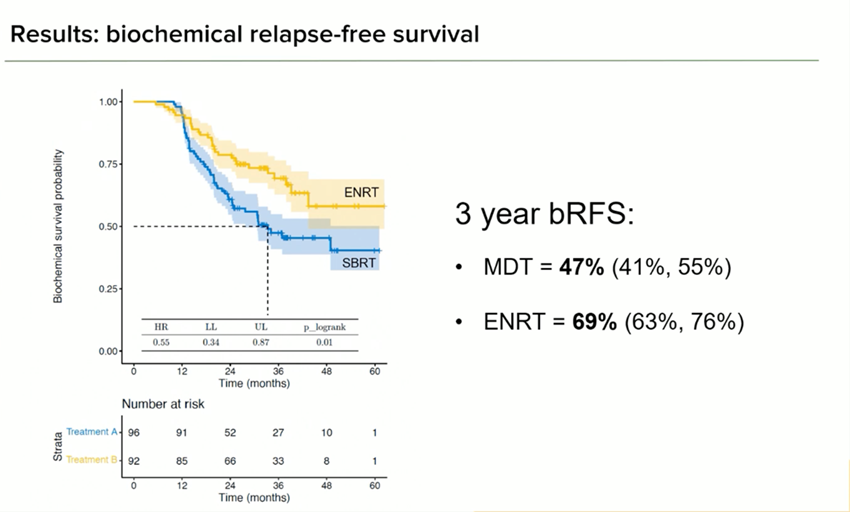Optimal Treatment Strategies for Pelvic Nodal Oligo-Recurrence in Prostate Cancer: Insights from the STORM Trial
ESTRO 2024 Congress report
Pelvic nodal oligo-recurrence after radical treatment for prostate cancer is common and yet is the subject of controversy. Is the optimal treatment to irradiate all pelvic nodes while providing androgen deprivation therapy (ADT) or to offer stereotactic body radiation therapy (SBRT), alone or with ADT, to the visible disease on imaging?
The Salvage Treatment of Oligo-Recurrent nodal prostate cancer Metastases (STORM) trial, which was presented by Professor Piet Ost at ESTRO 2024, has answered this question. STORM is an international, multicentre phase-II trial, to which 196 patients who had undergone previous radical treatment (prostatectomy or radiotherapy to the prostate, or both) and had normal levels of baseline testosterone were recruited. Most patients had a single area of nodal relapse (note: 83% were staged by prostate-specific membrane antigen positron emission tomography) and were randomised to elective nodal radiotherapy (ENRT) or to SBRT to the visible node only, alongside six months of ADT in both arms. Surgery was allowed as metastasis-directed therapy to the node, instead of SBRT, but was rarely used.

Prof Piet Ost presenting the STORM trial at ESTRO 2024
Gastrointestinal (GI) toxicity was low in both arms; grade 2+ toxicity was seen in 5.3% of patients after SBRT vs. 6.6% after ENRT over the two years after treatment.
Grade 2 or higher genitourinary (GU) toxicity was seen in 22.2% of patients after SBRT vs. 26.5% after ENRT over the two years that followed treatment, but persistent toxicity was more commonly seen in the ENRT arm.
There was an imbalance in the percentage of patients who received prostate bed radiotherapy alongside nodal radiotherapy; in the ENRT arm, this was 41%, vs. 25% in the SBRT arm (hazard ratio: 0.55). With logistic regression, the team found that prostate bed radiotherapy more than doubled the risk of G2 GU toxicity.
After SBRT, 25% had pelvic nodal relapse compared with 3% in the SBRT arm. Omission of prostate bed radiotherapy trebled the chance of a prostate bed recurrence (14% vs. 5%).
The main results showed an improvement in biochemical relapse-free survival rates from 47% in the SBRT arm to 69% in the ENRT arm (p=0.01).

Locoregional relapse-free survival was similarly improved, from 70% to 90% (p=0.002).

Data on metastasis-free survival is awaited; currently, there are too few events to analyse, which is great news for STORM patients. On the basis of the data presented, ENRT should be considered optimal care for men who wish to maximise their biochemical and relapse-free survival outcomes.

Dr Alison Tree
The Royal Marsden NHS Foundation Trust and The Institute of Cancer Research
Surrey, UK
References
Proferred paper 2077, ESTRO 2024: Ost et al, Salvage treatment of oligo-recurrent nodal prostate cancer metastases (STORM)